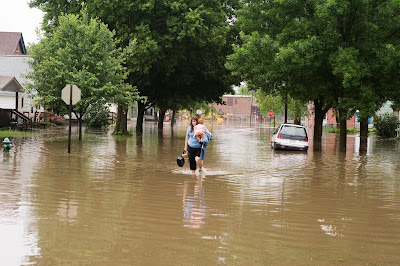The National Weather Service To Further Complicate Flood Warnings In the Name of Simplification
I can hardly believe what I just read: the National Weather Service (NWS) is going to extend its awful 'impact-based' tornado warning concept to its flash flood warnings. There is so much wrong with this, I hardly know where to begin.
Before we go further, I am basing what I am writing about the new flash flood warnings on NBC News' and The Washington Post's coverage of this announcement.
"Impact-Based" (paraphrasing: 'you will die if not in shelter') tornado warnings (IBW) were/are designed to scare people into taking action (since their introduction, they've toned down the language just a bit). The motivation for IBW was the National Weather Service's failure to grasp what actually went wrong in the Joplin Tornado catastrophe. In the wake of the worst death toll in more than sixty years, the worst of the tornado warning era, the NWS issued a highly flawed report (and that characterization is giving them the benefit of the doubt) about the disaster which has misguided them ever since. What really went wrong in Joplin was the subject of my second book.
With IBW, the NWS went from one type of tornado warning to three.
Before we go further, I am basing what I am writing about the new flash flood warnings on NBC News' and The Washington Post's coverage of this announcement.
"Impact-Based" (paraphrasing: 'you will die if not in shelter') tornado warnings (IBW) were/are designed to scare people into taking action (since their introduction, they've toned down the language just a bit). The motivation for IBW was the National Weather Service's failure to grasp what actually went wrong in the Joplin Tornado catastrophe. In the wake of the worst death toll in more than sixty years, the worst of the tornado warning era, the NWS issued a highly flawed report (and that characterization is giving them the benefit of the doubt) about the disaster which has misguided them ever since. What really went wrong in Joplin was the subject of my second book.
With IBW, the NWS went from one type of tornado warning to three.
- 'Ordinary' tornado warnings
- Particularly dangerous tornado warnings
- Tornado emergency (the 'you will die'-type)
The problem is that we did not, and still do not, have the scientific skill to do these with any consistent quality. Plus, in may opinion, all tornado warnings are emergencies and should be treated accordingly. By creating unreliable sub-types of tornado warnings, it is possible we are training people to, at their peril, ignore 'ordinary' tornado warnings.
And, as some of us predicted, with the added complexity, NWS tornado warnings have become less accurate.
So, with the new flash flood warnings, a lot is going to change. We will have,
- 'Ordinary' or 'base' flash flood warnings.
- 'Considerable' flash flooding.
- 'Catastrophic' flash flooding.
Keep in mind, these are on top of areal flood warnings, flood warnings, arroyo flood warnings, urban and small stream flood warnings, et cetera.
As NBC News reported,
The impact-based warnings will fall into three categories: base, considerable and catastrophic. The latter two, considerable and catastrophic, which warn of floodwaters that could severely impact lives and property, will be the approximately 20 percent of warnings that the NWS will push out to people’s phones.
Question #1: if the flooding isn't expected to affect property or lives, why is a flash flood warning being issued in the first place? This is the root problem: the NWS issues way too many flood warnings under too many classifications (no one knows what an 'areal' flood warning is). And, this problem is exaggerated by the fact there is little or no consistency in warning thresholds between NWS offices when it comes to tornado or flash flood warnings. For example, what prompts the Springfield NWS office to issue a tornado warning is quite different from what prompts the Wichita office. And, while there should be, there are no "best practices" or quality standards.
So, to 'fix' the "overwarning" and confusion issues, the NWS's plan is that only the "considerable" and "catastrophic" flash flood warnings will be pushed out to our smartphones under the, often flawed, FCC's WEA ("wireless emergency alerts") system. This is doubling down on failure rather than fixing the root problem.
Question #2: Given it has taken decades to educate the public on the difference between watches and warnings, how does the NWS possibly hope to immediately educate people on the difference between these new types of warnings? Time is of the essence given the life-threatening nature of flash floods.
The ultimate irony is that the NWS is doing this under the rubric of "warning simplification" and it will begin in less than 90 days.
I'd love to be able to end this piece on some type of "up note" but I don't have one. The NWS is an organization with increasingly serious issues that seems to have lost its way.






Comments
Post a Comment